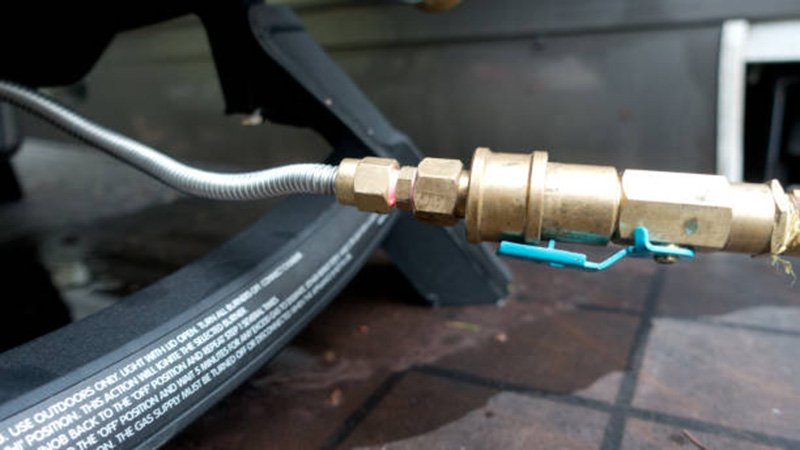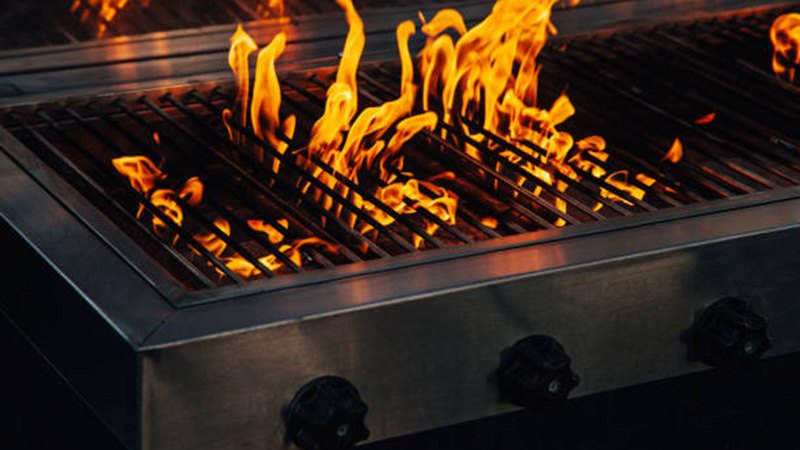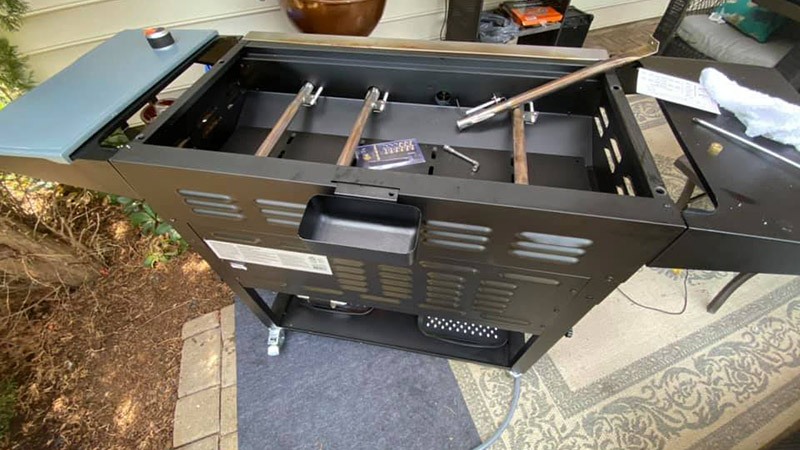Gas grills can develop problems after extended use, just like any other mechanical equipment. However, a grill does not necessarily have to be old to be faulty.
A grill can show many different signs when it is not working well. When you see these signs of gas grill problems, you don’t need to buy a new one right away. Rather, you should try out some troubleshooting tricks that could return the grill to perfect working order. In this guide to gas grill troubleshooting, we’ll break down the most common problems you might encounter and provide simple steps to get your grill back in working order.
Safety First
Before you take any troubleshooting steps, you want to make sure that you’ve taken the required safety precautions to prevent any fire hazard. The most important precaution when dealing with propane tanks is to turn off the tank valve and disconnect the grill from the fuel source. When performing any propane gas grill troubleshooting, always start by turning off the propane tank valve to ensure safety.
Let the grill cool down completely if you’ve recently used it. Waiting a few minutes after turning off the grill helps the gas to fully dissipate.
A Guide to Troubleshooting Your Gas Grill
1. Low Flame from Burners
Experiencing a low flame? This is one of the most common problems in gas grill troubleshooting. Let the grill cool down completely if you’ve recently used it.
Over time, the fuel gas line regulator can become sticky. When this happens, it limits gas flow. This reduces the flame intensity and affects the grill’s temperature. If you’re experiencing gas grill troubleshooting low flame issues, the regulator might be the cause.
Troubleshooting this problem is simple. All you need to do is release the pressure on the regulator:
- Ensure that you turn off the gas supply at the propane tank and disconnect the hose and regulator from the tank.
- Open the grill lid.
- Open all the control knobs to high and leave for 1 – 2 minutes to let all the gas in the manifold escape.
- Turn all the control knobs off.
- Reattach the gas hose and regulator to the tank.
- Slowly turn the knob controlling the gas supply from the tank to allow the line to re-pressurize.
- Ignite the grill, ensuring proper grill igniting procedures are followed.
- It should burn and heat normally by now
2. Gas Grill Doesn’t Light

If your gas grill won’t light, don’t panic! Before diving into gas grill troubleshooting, try lighting it manually with a match or lighter. If it lights up, then you know the problem is with the ignition system rather than issues with the way the gas flows.
There are different types of ignition systems used in gas grills. The most popular are:
- Piezo
- Flame Thrower Valve
- Battery Powered
- Electrically Driven Ignition
If your gas grill has separate igniters for each burner and none work, the issue might be faulty wiring or a broken button. On the other hand, if you have independent igniters and one burner doesn’t light, then the problem is with that igniter.
To fix the igniter, remove the cooking grates. Then, take off the barrier to reach the igniter’s spark generator.
Push the ignition button and look out for small sparks and audible clicks. Clean the igniter if it is clogged. If it isn’t clogged, there could be faulty wiring or a faulty switch.
3. Orange/Yellow Flame

An orange or yellow flame is a common issue in gas grill troubleshooting. This usually indicates uneven fuel flow or an unbalanced air-gas mixture. Here’s what you can do in a situation like this.
- Look for the venturi tube adjustment screw. Locate it at the end of the burner, by the metal shutter. The screw controls the opening and closing of the shutters.
- Ignite the grill and put the flame on a very low setting.
- Adjust the screw till you get a blue or mostly blue flame. If you’re experiencing gas grill troubleshooting yellow flame issues, adjusting the venturi tube can often resolve the problem.
- As soon as you have a satisfactory blue flame, turn off the burner and tighten the adjustment screw.
Furthermore, the wrong type of gas may also cause a yellow or orange flame. For example, a grill designed for natural gas can give out yellow/orange flame when you try to use propane.
4. Uneven Heating
When troubleshooting a gas grill with uneven heating, the culprit is often a blocked or damaged burner. Burners come with holes through which gas is emitted to burning flames.
Over time, some of the holes can get clogged by drippings or other dirt. Just use a wire brush to clear any material clogging the burner. This will help distribute heat properly.
However, if that doesn’t get rid of all the dirt, you may have to remove the burner from the grill for a more thorough cleaning. Thankfully many grills have burners you can easily lift out, although some are bolted in place and harder to remove.
Take the burner off the grill. Clean it well with a stiff wire brush. Make sure to remove any dirt blocking the holes.
5. Flame From the Control Panel
The flame from behind the control panel is usually caused by a blockage or misalignment of the venturi tubes. After the grill has cooled down, inspect the connection and for any misaligned or loose parts. Check the tubes and hoses for cracks or burn-throughs.
Gas Grill Parts

Grilling usually happens outside, so most parts of a gas grill are made of stainless steel. This material helps protect the grill from the weather. Cast iron has its uses, but staying rust-free outdoors isn’t one of its strong suits. Depending on your make and model, these are the usual suspects making up your gas grill.
Tank
The propane tank holds the fuel the burns to produce heat in the grill. The tank is usually one of the strongest parts of your grill. It is very unlikely to have a damaged or faulty gas tank.
Fuel Hose and Regulator
The amount of fuel that comes from the tank to the grill is more than you need for grilling. The regulator regulates the flow of fuel delivering gas to the grill, and it is attached to the tank with a hose and regulator and an O-ring. Regulators have vent holes that could get clogged and lead to irregular fuel flow. Be sure to double-check the fuel hose and its connection, as these can be locations for gas leaks.
Control Valves
Control valves regulate fuel flow to the burner. Every burner on a gas grill will come with a control valve. When a control valve starts to malfunction, replacing the whole control valve is usually the best thing to do. Consult the user manual for obtaining proper replacement parts.
Venturi Tubes
Venturi tubes are an important part of a gas grill. They connect the burner to the control valve. They also mix fuel with air.
Because of the opening in the fuel line, foreign objects can easily get in and block the line. Also, it is common for venturi tubes to be misaligned with burners.
Burners
This is the part where the combustion takes place to produce heat in a gas grill. Burner ports can get clogged and corrode easily. A burner that’s overly corroded should be replaced. Nevertheless, a decent burner should remain functional for about three years at the very least.
Conclusion
You can’t write off malfunctions when it comes to gas grills. Just like any other mechanical equipment, they can develop faults at any point in time. Not everyone is handy enough or skilled enough to make extensive repairs on gas grills.
However, most gas grill issues you would face will only need simple remedies you would be able to administer. We hope these gas grill troubleshooting tips help you keep your grill in top shape.
While this guide provides general gas grill troubleshooting tips, remember that specific models (like Char-Broil or Weber) might have unique quirks. Always consult your owner’s manual for model-specific advice, including Char-Broil gas grill troubleshooting or Weber gas grill troubleshooting.
For expert help with mechanical repairs beyond your grill, check out Rolon Mobile Truck Repair services. They make sure you’re always ready for any situation.
With the right troubleshooting trick, you’ll be able to get your gas grill working properly in no time. Hempen Hill BBQ has covered most of the issues you could face with your gas grills and tricks you can try out to fix the issues.
FAQs About Gas Grill Troubleshooting
Why won’t my gas grill light?
There are a few reasons why your gas grill might not be lighting. Here’s a breakdown of the most common causes and how to troubleshoot them:
Problem with the Igniter: If you hear clicking but no spark, the igniter could be faulty. Try cleaning the igniter or replacing it if necessary.
Gas Flow Issues: Check if the propane tank is empty or if the gas line is blocked. Ensure the regulator is functioning correctly and that the control valves are open.
Burner Problems: Clogged burner ports can prevent gas from flowing properly.
Clean the burners with a wire brush to remove any debris.
Why is my propane tank full but low flame?
Even with a full propane tank, you might experience low flames due to:
Sticky Regulator: The regulator controls gas flow, and if it’s sticky, it can restrict the amount of gas reaching the burners. Try resetting the regulator by following the steps outlined in the “Low Flame from Burners” section of the article.
Blocked Gas Line: Debris or spider webs can obstruct the gas line. Disconnect the line and check for any blockages.
Venturi Tubes: Misaligned or blocked venturi tubes can disrupt the gas and air mixture, resulting in low flames. Adjust or clean the venturi tubes as needed.
How do you light a gas grill?
Most modern gas grills have built-in igniters. Here’s the general process:
1. Open the Grill Lid: Important for safety to prevent gas buildup.
2. Turn on the Gas: Slowly open the propane tank valve.
3. Push the Ignition Button: Press and hold the igniter button for the specific burner you want to light. You should hear a clicking sound and see a spark.
4. Adjust the Flame: Once the burner is lit, use the control knob to adjust the flame to your desired intensity.
How to light a gas grill with a broken igniter
If your igniter is broken, you can light your gas grill manually:
1. Open the Grill Lid: Safety first!
2. Turn on the Gas: Slowly open the propane tank valve.
3. Use a Long Lighter or Match: Light a long match or a grill lighter.
4. Light the Burner: Carefully hold the flame near the burner you want to light.
5. Adjust the Flame: Once the burner is lit, use the control knob to adjust the flame.
How do you tell if a propane tank is empty?
Weight Test: The most reliable method is to weigh the tank. A standard 20-pound propane tank weighs about 37-38 pounds when full and around 18 pounds when empty.
Warm Water Test: Pour warm water down the side of the tank. The tank will feel cool to the touch where there is propane and warmer where it’s empty.
Fuel Gauge: Some propane tanks have built-in gauges, but they can be inaccurate.
